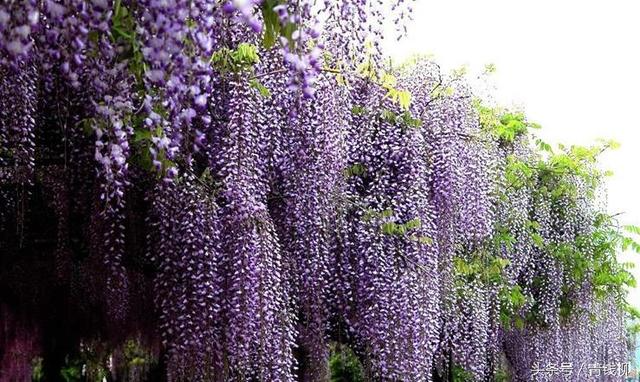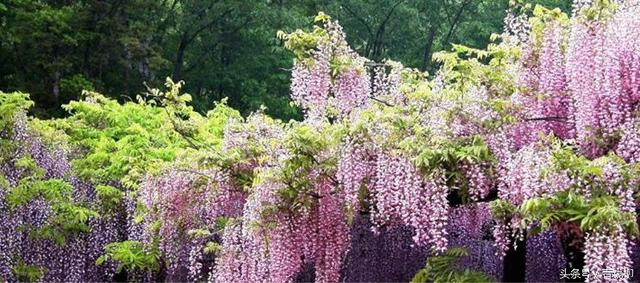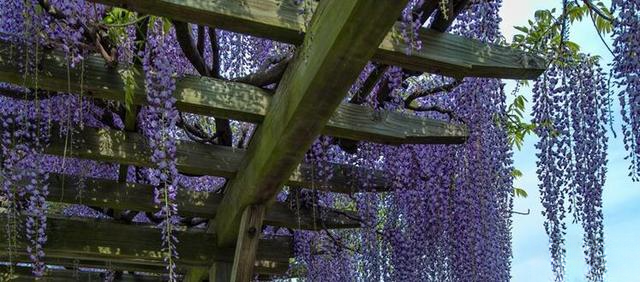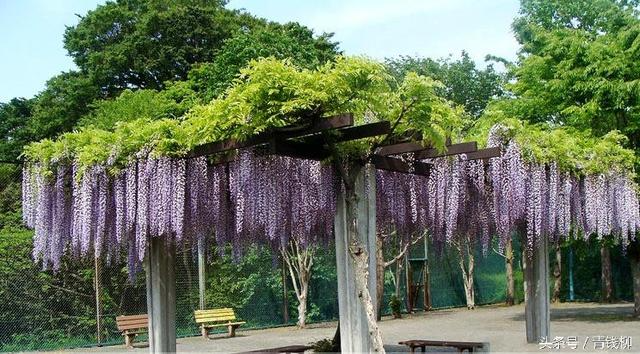Cultivation techniques of wisteria seedlings and flowers
Cultivation techniques of wisteria seedlings and flowers
Wisteria is a large woody deciduous vine of the genus Wisteria in the Fabaceae family. It has winding stems and dense branches and leaves. In early summer, purple spikes hang down, and the flowers are numerous and fragrant. In midsummer, the thick leaves fill the trellis and the pods are numerous. It is an excellent flower-viewing vine.
Wisteria can grow up to 10 meters tall, with gray-brown stems that twine and rotate counterclockwise. It has odd-pinnate compound leaves, lateral racemes that droop, and large purple or dark purple, fragrant flowers that open at the same time as the leaves. Wisteria likes a warm, humid, and sunny environment. It is relatively cold-resistant, tolerant of waterlogging and semi-shade, grows fast, and has a long lifespan. The optimal growth temperature is 20℃ to 30℃, and it can tolerate -8℃ in winter. The soil should be deep, well-drained sandy loam.

Reproduction method
Wisteria can be propagated by sowing, cuttings, grafting, layering, and division. Sowing, cuttings, and grafting are the most commonly used methods in production.
Seed propagation
①Seed collection. Wisteria seeds can be harvested when they mature at the end of October. After harvesting, remove the peel, spread it on the ground to dry in the shade, put it into a sack, and place it in a cool place to prevent rodent damage.
② Field preparation. Plow the field once in the winter of the year before sowing, apply fully decomposed cake fertilizer at a rate of 200 kg per mu, and use a rotary tiller to level the field 2 to 3 times to fully crush the soil. Make beds according to the seedling field, and make trenches with a width of 1.5 m. The open-field seedling bed is usually about 1.2 m wide and 10 to 30 m long according to the terrain. The walking path (ditch) is 30 cm wide. It is advisable to choose a high bed locally, and the bed surface is 20 to 30 cm higher than the walking path, which is conducive to ventilation, drainage and the increase of fertile soil layer.
③ Sowing. Calculate the sowing amount according to the land area. Before sowing, soak the wisteria seeds in 50℃ warm water for 24 hours, with the ratio of seeds to water being 1:3. After soaking, sterilize the seeds with 0.5% potassium permanganate for 20 minutes (only when the embryo has not broken through the seed coat), pick them up and drain them. Sowing in March, row sowing, and dig sowing furrows before sowing. The direction of the sowing furrow (seedling row) is consistent with the width of the seedbed. Sow the seeds evenly in the furrow according to the planned sowing amount. After sowing, cover with a layer of loose fine soil 1 to 2cm thick, and cover with straw, sawdust, husks, etc. to keep the soil moist and prevent rain erosion. Keep the soil semi-moist according to the situation to facilitate seed germination. After about 30 to 40 days, the seeds germinate, and the covering is gradually removed. The seedlings need to be cultivated for 2 years before they can be planted.

Cutting propagation: Wisteria cuttings are relatively easy, and both hard branch cuttings and root cuttings can be used.
① Preparation before cutting. Choose a seedling field with good drainage, low groundwater level, convenient transportation and abundant water source as the cutting bed. Do not apply basal fertilizer to the field before cutting, and prepare the field for the bed.
② Cultivation of the mother garden. Spray the wisteria mother tree with 0.1% potassium dihydrogen phosphate or foliar fertilizer once 10 days before cutting, and spray it again 5 days before cutting to improve the nutritional vitality of the mother tree. In case of drought, water the wisteria mother tree thoroughly two days in advance.
③ Hardwood cuttings. In mid-to-late March, select 1- to 2-year-old sturdy branches, cut into 15 cm sections, with 2 to 3 fully plump axillary buds (nodes) in the middle of each section, cut flat at the top and obliquely at the bottom, keep the row spacing at 20 cm, and insert into 2/3 of the seedbed. Keep the soil semi-moist after cutting. It will take about 25 to 30 days for the roots to grow.
④ Root cuttings. In mid-to-late March, dig out the 1-2 cm thick root system of Wisteria, cut it into cuttings of about 10 cm, and insert it into the seedbed. The cutting depth should be level with the ground. It will take about 25-30 days for the roots to take root and sprout.

Grafting propagation is carried out in spring before the wisteria sprouts. Ordinary wisteria is used as the rootstock and the excellent varieties are used as the scion. Branch grafting or root grafting is adopted. Select the branch segments with strong growth and full side buds as the scion, cut into wedge shape, cut the rootstock, and align the cambium of the scion with the rootstock. When inserting the scion, it should be noted that the thickness of the scion and the rootstock are equal. After insertion, tie it immediately, and the binding material must cover the wound completely. The survival situation can be checked 15 to 20 days after grafting. At this time, if the buds on the scion have sprouted or not sprouted, and the buds are still fresh and full, and the interface produces healing tissue, it means that it has survived. If the scion is dry or black or even rotten, it means that it has died and can be re-grafted later. For the wisteria that survives the grafting, the rootstock should be cut in time and the sprouts should be removed. Because wisteria has a strong upright nature, a frame must be built before planting, and strong and durable materials must be used.
Layering propagation: After the leaves of wisteria fall in autumn, bend 1-2 year old branches to the ground, peel off some of the skin and press them into the soil. After the branches take root, separate them from the mother plant. One branch can produce multiple seedlings.
Propagation by division: Dig up the soil on one side of the wisteria to expose the root system, dig out the sprouts with certain stems and root systems with their roots, and plant them separately.

Seedling management
Watering and drainage At the turn of spring and summer, seedlings are in a vigorous growth period and require more water. It is advisable to irrigate 2 to 3 times. During the rainy season, attention should be paid to drainage. In summer drought, the number of irrigations should be increased. In late autumn, in order to make the tissues old and healthy and conducive to wintering, irrigation is generally not required. No irrigation in winter.
Topdressing can be combined with watering to improve fertilizer efficiency. From June to early August, apply 3 to 5 kg of urea per mu, and water while applying topdressing. Apply once every 10 to 15 days, in small amounts and multiple times, to prevent root damage and seedling burn. Stop topdressing in late August to prevent seedlings from growing too tall and facilitate wintering.
Weeding: Weed manually to prevent chemical weeding. Weed at least once a month from April to September to remove weeds in the seedbed, furrows, and surrounding furrows to promote the healthy growth of Wisteria.
Pest and disease control Anthracnose and rot diseases often occur, which can be sprayed with 1000 times diluted 70% thiophanate-methyl wettable powder. In summer, it is easy to be harmed by thorn moths, aphids and borers, which can be sprayed with 800 times diluted dichlorvos for 2 to 3 times, once every 7 to 10 days, which can effectively control pests and diseases.

Large seedling cultivation
Wisteria has deep taproots and shallow lateral roots, and is not tolerant to transplanting. It must be transplanted with more soil, and a support must be set up after planting so that the branches and leaves can climb on it. In early spring, before the buds and leaves sprout, digging trenches and applying fertilizers around the roots will be beneficial to the growth of stems and leaves. In summer, pruning can be done to remove excessive branches and shorten weak branches to promote the formation of flower buds. In autumn, dense branches and diseased branches should be thinned out to facilitate flowering the following year.
